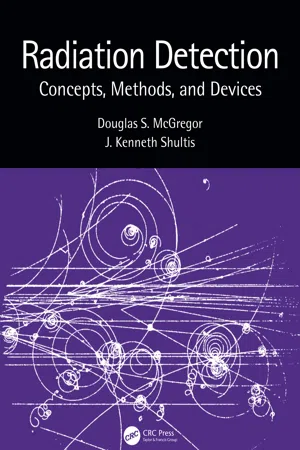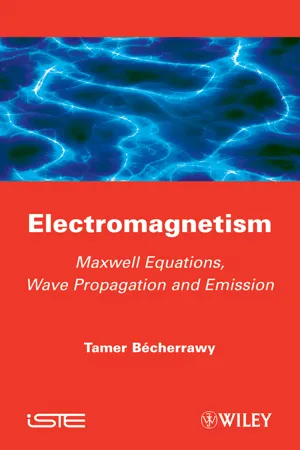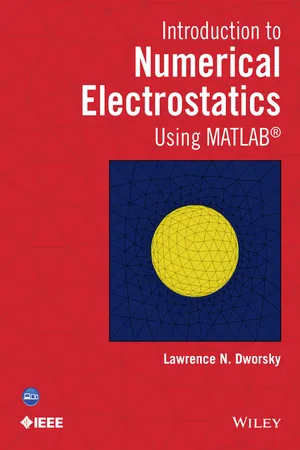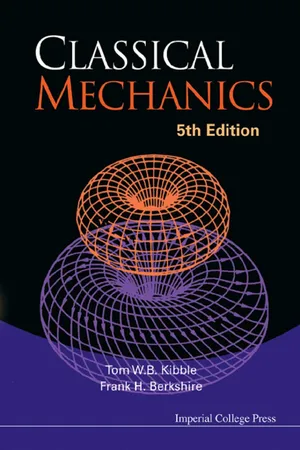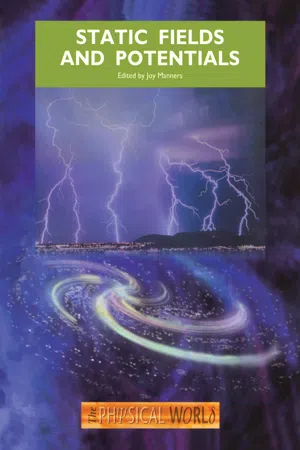Physics
Electric Potential
Electric potential is a scalar quantity that represents the potential energy per unit charge at a specific point in an electric field. It is measured in volts and is a fundamental concept in understanding the behavior of electric charges and electric fields. The electric potential at a point is the work done per unit charge in bringing a positive test charge from infinity to that point.
Written by Perlego with AI-assistance
Related key terms
Related key terms
1 of 4
Related key terms
1 of 3
11 Key excerpts on "Electric Potential"
- eBook - ePub
- Sivaji Chakravorti(Author)
- 2017(Publication Date)
- CRC Press(Publisher)
q is located at a given position within an electric field produced by a system of charges. The test charge will experience a force due to the source charges. If the test charge moves in the direction of the field forces, then the work is done by the field forces in moving the test charge from position 1 to position 2. In other words, energy is spent by the electric field. Hence, the potential energy of test charge at position 2 will be lower than that at position 1. On the other hand, if the charge is moved against the field forces by an external agent, then the work done by the external agent will be stored as potential energy of the test charge. Hence, the potential energy of the test charge at position 2 will be higher than that at position 1. Here, it is to be noted that the force experienced by the test charge within an electric field is dependent on the magnitude of the test charge. Hence, the potential energy of the charge at any position is dependent on its magnitude and the distance by which it moves within the electric field.The concept of Electric Potential is introduced to make it a property, which is purely dependent on the location within an electric field and is independent of the test charge. In other words, it is a property of the electric field itself and not related to the test particle. Hence, Electric Potential (ϕ) at any point within an electric field is defined as potential energy per unit charge at that point and hence it is a scalar quantity. The unit of Electric Potential is volt (V), which is equivalent to joules per coulomb (J/C). It is interesting to note that electric field intensity is defined as force per unit charge and Electric Potential is defined as potential energy per unit charge.However, it is also practically important to note that absolute values of Electric Potentials are not physically measurable; only difference in potential energy between two points within an electric field can be physically measured; that is, only the potential difference between two points within an electric field is measurable. The work done in moving a unit positive charge from one point to the other within an electric field is equal to the difference in potential energies and hence difference in Electric Potentials at the two points.FIGURE 1.7 Pertaining to the definition of Electric Potential.As shown in Figure 1.7 a, consider that a unit positive charge is moved from point 1 to point 2 by a small distance dl . The force experienced by the unit positive charge at point 1 is the electric field intensityE →. Then the potential difference between the ending point 2 and starting point 1 is given byϕ 2-ϕ 1= -E →⋅d l→ ( 1.16 )In the above equationis the work done by the field forces in moving a unit positive charge from point 1 to point 2. In this case, the potential energy of point 2 will be lower than that of point 1 and hence the potential difference (ϕ2 −ϕ1 ) will be negative. For this purpose, the minus sign is introduced on the right-hand side (RHS) of Equation 1.16E →⋅d l→ - eBook - ePub
- A. L. Stanford, J. M. Tanner(Authors)
- 2014(Publication Date)
- Academic Press(Publisher)
13Electric Potential
Publisher Summary
This chapter discusses Electric Potential. Electric fields are vector fields that have both magnitude and direction at every point at which the field is defined. The electrical properties of space can also be described by Electric Potential, which is, in some respects, a simpler and more practical concept than the electric field. Electric Potential is simpler than electric fields because Electric Potential is a scalar quantity and, therefore, has no direction associated with it. Electric Potential is more practical than the electric field because differences in potential, at least on conductors, are more readily measured directly. Electric Potentials and electric fields in a given region are related to each other, and either can be used to describe the electrostatic properties of space. The gravitational potential energy of an object at a point is meaningful only in terms of the difference in potential energy between that point and the potential energy specified at some reference point. Electric Potential should have characteristics similar to those of gravitational potential energy for Electric Potential to be equally useful.We have stressed that electric fields are a means of characterizing a physical property of space caused by the presence of electrostatic charge. Electric fields are vector fields that have both magnitude and direction at every point at which the field is defined. The electrical properties of space can also be described by Electric Potential, which is, in some respects, a simpler and more practical concept than the electric field. Electric Potential is simpler than electric fields because Electric Potential is a scalar quantity and, therefore, has no direction associated with it. Electric Potential is more practical than the electric field because differences in potential, at least on conductors, are more readily measured directly. - No longer available |Learn more
- Robert A. Pelcovits, Joshua Farkas(Authors)
- 2023(Publication Date)
- Barrons Educational Services(Publisher)
V (a scalar quantity) as this ratio:If we define potential as above, we can easily calculate the potential energy U of a charge of any value simply by multiplying the value of the charge by potential. For example, for charge 1, Ucharge 1 = Q1 V.Recall that the magnitude of any form of potential energy is arbitrary; only differences in potential energy have meaning. We then define voltage as the difference between the potentials at points 1 and 2 in space:TIPVoltage is the potential difference between two points.Repeating the above derivation for very small ΔU and ΔV (such that these are differential differences), we can obtain a differential statement:Definitions of potential and voltageThe units of potential and change in the potential energy of voltage are volts, given by 1 volt = 1 joule/coulomb. One electronvolt is the amount of energy stored by a charge of e when it moves through a potential difference of 1 volt: 1 eV = (1.60 × 10− 19 C)(1 V) = 1.60 × 10− 19 J. As indicated by this equation, an electronvolt is a measure of energy, not voltage (it’s simply an alternative unit for energy that is handy when working at the atomic scale).Electrostatic Force as a Conservative Force
Recall from mechanics that not all forces have an associated potential energy function; only conservative forces do. Thus, by saying that a potential energy or potential function even exists, we are assuming that the electrostatic force is conservative. This is fairly clear from the fact that Coulomb’s law has the same mathematical form as the universal gravitational force, which we know to be conservative. The fact that we will be able to determine potential functions later in this chapter confirms this assumption. - eBook - ePub
Radiation Detection
Concepts, Methods, and Devices
- Douglas McGregor, J. Kenneth Shultis(Authors)
- 2020(Publication Date)
- CRC Press(Publisher)
potential, which is defined as the potential energy per unit charge,V =U=Q ′14 πϵ o∑i = 1n,Q ir i(8.16) and is expressed in units of volts (or joules per coulomb). Note that the potential is no longer dependent upon the “test” charge Q′ .3 The force exerted upon Q′ may also be expressed in terms of the electric field, produced by one or more point charges, in whichF =. Substitution ofQ ′Einto Eq. (8.13 ) and division by Q′ gives the potential difference between two points within the electric field. Hence, the potential difference between arbitrary locations a and b isq ′EV= Δ V =a b∫ a bE ⋅ d l =∫ a bE cos θ d l .(8.17) In summary, Eq. (8.17 ) is the voltage that an experimenter would measure between two points (a and b) within an electric field. The work done on a unit test charge moving from some point a to another point b in the electric field is Q′ Vab.8.3CapacitanceConsider the arrangement depicted in Fig. 8.6 . Two conductive plates, separated by a distance d, have equal, but opposite, charges. An electric field is produced between the plates by the charges on the plates. The positively charged plate (or terminal) has a voltage V1 and the negatively charged plate has a voltage V2 . The capacitance of the two plates is defined as the ratio of the charge magnitude on either plate to the magnitude of the potential difference between the plates,C =|.Q|Δ V(8.18) If ΔV is taken as the applied voltage V between the electrodes, then the above definition gives the important relationC V = Q(8.19) The SI unit for capacitance is the farad (one coulomb per volt). The reader should understand that the charge stored in a capacitor has a summed positive charge on one terminal and an equal summed negative charge stored on the opposite terminal; hence, a capacitor with stored charge Q actually has +Q on one terminal and −Q - eBook - ePub
Dielectrophoresis
Theory, Methodology and Biological Applications
- Ronald R. Pethig(Author)
- 2017(Publication Date)
- Wiley(Publisher)
We can express this relationship as: (4.13) As expected, this gives the equivalent result to Equation (4.9). We have q 1 = q 3 = 1.4 pC; q 2 = −1.0 pC; r 13 = 2 mm; r 23 = 1 mm. Thus, from Equation (4.13): Positive work has been performed by the net field of q 1 and q 2 in bringing q 3 into position. The attractive force that q 2 exerts on q 3 is thus greater than the repulsive force exerted by the far more distant q 1 and the net electrical potential energy has decreased. (Bringing like charges together increases their potential energy; bringing unlike charges together decreases their potential energy.) 4.3 Electrical Potential The electrical potential V at any point in an electrical field is defined as the potential energy U per unit charge associated with a test charge Q 0 located at that point in the field: (4.14) In the SI system of units the unit of electrical potential is the volt: In Chapter 2 the concept of an electrical field was described as the force per unit charge that the field exerts on a test charge Q 0. An electric field E thus has units of N/C, which is equivalent to (N.m/C)/m. From Equation (4.14), a potential V has units of N.m/C. In other words, the unit of electric field can be expressed as one volt per metre. This is the unit commonly used by electrical and electronic engineers and will be adopted in this book. Expressing Equation (4.6) on a per unit charge basis we have: (4.15) We interpret this equation as stating: ‘The potential difference (V a − V b) between location a and location b is equal to the work done by an electric field in moving a body of unit charge from a to b in this field.’ A potential difference (V a − V b) becomes a useful concept if we can define V a as a reference potential - eBook - ePub
Electromagnetism
Maxwell Equations, Wave Propagation and Emission
- Tamer Becherrawy(Author)
- 2013(Publication Date)
- Wiley-ISTE(Publisher)
12 eV are also used.The drop in potential is the work of the electric force on the positive unit charge. We may also interpret the increase of V as the work of an external agent in displacing the positive unit charge without varying its kinetic energy. This work is independent of the path because E is conservative. Particularly, if the potential is taken to be zero at infinity, as in the expressions [2.7 ], the potential V(r) is the work that is required to bring the unit charge from infinity to the point r along any path.Figure 2.1.a) Cylindrical coordinates, and b) spherical coordinates
a) Evaluation of the field from the potential and the potential from the field In the case of time-independent phenomena, the electric field is conservative and we may introduce the electrostatic potential such that2.3. The two fundamental laws of electrostatics[2.8]Considering a displacement δr = δl e along an arbitrary axis D of unit vector e, the variation of the potential is is the component of E along D . We deduce that[2.9]This relation holds even if we know V only on the line D and it may be generalized to curvilinear coordinates. We obtain in the case of cylindrical coordinates and spherical coordinates (see Figure 2.1 ):[2.10][2.11 ]The relation E = −∇V shows that, if V is constant, E = 0 and conversely, if E = 0, V is constant. The surface of equation V(r) = C , where C is a constant, is an equipotential surface (see Figure 2.2 ). As the potential has a unique value at each point r, two equipotential surfaces cannot intersect. The field E - eBook - ePub
Molecular Driving Forces
Statistical Thermodynamics in Biology, Chemistry, Physics, and Nanoscience
- Ken Dill, Sarina Bromberg(Authors)
- 2010(Publication Date)
- Garland Science(Publisher)
21 The Electrostatic Potential We Switch from Fields (Forces) to Electrostatic Potentials (Energies)The electrostatic field, introduced in Chapter 20 , describes forces, which are vector quantities. In this chapter, we switch to the electrostatic potential, which describes energies, which are scalar quantities. We switch for two reasons. First, scalars are easier to use than vectors. Second, our aim in Chapters 22 and 23 is to predict equilibria in systems in which charges play a role. To predict equilibria, we need energies.We also develop here Poisson’s equation. Poisson’s equation simplifies electrostatics calculations in many problems. We will use it in Chapter 22 to compute the energy for moving a charged particle, such as a salt ion or protein, in the vicinity of other charged objects such as proteins, colloids, DNA, polyelectrolytes, membranes, electrodes, or dielectric boundaries.What Is the Electrostatic Potential?The work dw that you must perform to move a charge q through a small distance dℓ in the presence of a fixed electrostatic field E is the negative of the dot product of the force f = qE and the displacement dℓ (see Equation (3.8) ):δ w = − f ⋅ d ℓ = − q E ⋅ d ℓ .(21.1) There is a minus sign in Equation (21.1) because this work is performed against the field, not by the field as in Equation (3.8) . To move a charge from point A to B, the total work wAB is given by the path integral (see Appendix G ),w= − qA Bℓ .∫ A BE ⋅ d(21.2) By equating wAB with the electrostatic energy, we are assuming, according to the First Law of Thermodynamics, processes that involve no heat exchange. In such cases, wAB is the maximum possible work and is called the reversible work - Lawrence N. Dworsky(Author)
- 2014(Publication Date)
- Wiley-IEEE Press(Publisher)
This implies that the electrostatic field is conservative—any path leading from point p back to point p will yield a zero-voltage difference. In other words, electrostatic energy is neither gained nor lost going around a closed path. An important point to make here, even though it is beyond the purview of this book, is that this is not a general electromagnetic system property—it is valid only in the electrostatic case. FIGURE 1.8 Electric field between two large parallel plates, near the center. Restating equation (1.21) to yield the field in terms of the voltage difference, in rectangular coordinates, we have (1.26) The operator ∇ is called the gradient operator. This equation shows clearly why an arbitrary reference voltage choice has no effect on the electric field. Suppose that there is a charge q at the origin of our coordinate system. If q is the only charge present, then no work was required to bring q from anywhere else to the origin. Now, let us bring a test charge from infinity (where the field due to q is zero) to some radius a. Using equation (1.21), we obtain (1.27) and using equation (1.2), the potential at a is (1.28) Equation (1.28) is a scalar equation, which is almost always easier to work with than is a vector equation. Also, once the voltage is known, it is a straightforward job to calculate the field. Consequently, we will concentrate on finding voltages and then (if necessary) finding the field, not the other way around. For the single-point charge of equation (1.28), we already know that the field lines point radially outward (from the charge), going to infinity. Figure 1.9. shows surfaces of constant potential, known as equipotential surfaces or more commonly equipotentials- eBook - ePub
- Adrian Waygood(Author)
- 2018(Publication Date)
- Routledge(Publisher)
V – depending on context (more on this later).We shall be examining the differences between potential and potential difference in more detail later in this chapter.The volt
We are now in a position to define the SI unit of both potential and potential difference, which is the volt , named in honour of the Italian physicist, Count Alessandro Volta (1745–1827).The volt (symbol: V ) is defined as ‘the potential difference between two points such that the energy used in conveying a charge of one coulomb from one point to the other is one joule’ .Again, you do not have to memorise this definition, however we will need to refer back to it when we discuss energy, work and power, in a later chapter.In practice, potential differences can vary enormously. For example, a simple AA disposable battery (or, more accurately, ‘cell’) will provide a potential difference of just 1.5 V, whereas electricity transmission voltages (in the UK) can be as high as 400 kV.The preceding definition may be expressed in the form of an equation:where:E =W Q- E = potential difference, in volts (symbol: V)
- W = work, in joules (symbol: J)
- Q = electric charge, in coulombs (symbol: C)
Worked example 1 The work done by a gener-ator in separating a charge of 20 C is 50 kJ.What is the resulting potential difference across its terminals?Solution Important ! Don’t forget, we must first convert the kilojoules to joules.E =W Q== 2.5 × 1( 5 0 × 10 3)2 00 3= 2500 V (Answer)Creating a potential difference through charge separation
So we now know what we mean by a potential difference and how it is measured. But how - eBook - ePub
- Tom W B Kibble, Frank H Berkshire(Authors)
- 2004(Publication Date)
- ICP(Publisher)
r) to be the electrostatic potential energy per unit charge,The potential due to charges qj at rThe acceleration of a charged particle is given byjis thenwhere the electric field E(r) is defined byNote that the acceleration depends on the charge-to-mass ratio q/m. (The corresponding ratio in the gravitational case is the ratio of gravitational to inertial mass, which is of course a constant, set equal to unity in conventional units. This proportionality is the content of the equivalence principle.)Unlike the gravitational potential, the electrostatic potential ϕ may have either sign, because both positive and negative charges exist.We can now forget about the particle at r, and concentrate on the problem of calculating the potential from given information about the positions of the masses or charges.6.2The Dipole and Quadrupole
The electric dipole consists of two equal and opposite charges, q and −q, placed close together, say at a and at the origin, respectively. (See Fig. 6.1 .) The potential isFig. 6.1We shall assume that a ≪ r, so that we may expand by the binomial theorem. Since we shall need the result later, we evaluate the terms up to order a2 , but neglect a3 . If θ is the angle between a and r, thenHence(The general term in this series is of the form (al /rl+1)Pl(cos θ), where Pl is a polynomial, known as the Legendre polynomial of degree l. Here, however, we shall only need the terms up to l = 2.) In vector notation, we may write (6.8) asWe now return to (6.7). Keeping only the linear term in a and neglecting a2 , we can write it aswhere d is the electric dipole moment, d = qa. The corresponding electric field, given by (6.6), has the spherical polar components (see (A.50))(To avoid any possible risk of confusion, we denote the potential and the azimuth angle by the distinct symbols ϕ and φ.) This field is illustrated in Fig. 6.2 , in which the solid lines are field lines, drawn in the direction of E, and the dashed lines are the equipotential surfaces, ϕ - eBook - ePub
- Joy Manners(Author)
- 2020(Publication Date)
- CRC Press(Publisher)
Examples of Electric Potentials and potential differences are all around and within us. Changes in the potential differences between the inside and outside of nerve fibres are the means by which electric signals are carried along the nerves. In the next chapter, you will see how potential differences between the terminals of batteries cause currents to flow through electric circuits. The build-up of electric charge in thunderclouds leads to potential differences between clouds and the Earth of hundreds of millions of volts.The cathode ray tube, which forms the basis of your television set, is a device in which electrons are emitted from a source and accelerated by a series of positive electrodes through a potential difference of about 20 000 V towards the screen. This makes the television set potentially by far the most lethal piece of electrical equipment in the home.We shall now consider some specific examples of the application of potential and potential energy.5.1 Hydroelectric power
The gravitational potential energy that water in mountain lakes possesses relative to lower levels is exploited in hydroelectric schemes. From early times, this energy was used in waterwheels. However, this source is not dependable. The modern waterwheel is the water-driven turbine of a hydroelectric generation plant. The basic requirement for a usable source of hydroelectric power is a river with sufficient flow to constantly replenish the lake. Compared with a site at the foot of the mountain, the water has a large amount of gravitational potential energy. If, therefore, the water is allowed to flow under gravity in a controlled manner to a lower level, it will lose potential energy and gain a comparable amount of kinetic energy. (There will be some loss of energy in the form of heat energy due to turbulence etc.) The kinetic energy may be converted into electrical energy by directing the water through one or more carefully designed nozzles on to the blades of a turbine.
Index pages curate the most relevant extracts from our library of academic textbooks. They’ve been created using an in-house natural language model (NLM), each adding context and meaning to key research topics.
Explore more topic indexes
Explore more topic indexes
1 of 6
Explore more topic indexes
1 of 4



